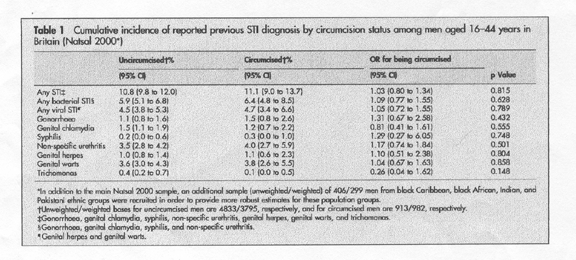
Sexually Transmitted Infections, Volume 79: Pages 499-500, December 2003.
Studies from developing countries1 and sexually transmitted diseases clinics in developed countries2 show that male circumcision appears to protect against some ulcerative sexually transmitted infections (STIs) and decreases the risk of HIV infection.3 We used data from the 2000 British National Survey of Sexual Attitudes and Lifestyles (Natsal 2000)—a large scale, stratified, probability sample survey—to estimate the prevalence of male circumcision in Britain and investigate its association with key demographic characteristics, sexual behaviours, and reported STI diagnosis. Natsal 2000 methodology details are published elsewhere.4 For the purposes of this investigation, data from targeted oversampling of black Caribbean, black African, Indian, and Pakistani groups (the Natsal ethnic minority boost) were combined with the main survey data in order to increase the numbers of these respondents included in the analysis. All data were weighted to be representative of the British population and analyses were performed using Stata version 6.0 to take into consideration Natsal 2000s complex survey design.4
We found 15.8% (95% confidence interval (CI) 14.7 to 17.1) of British men aged 16–44 years reported being circumcised in Natsal 2000. Age specific prevalence was greatest among men aged 40–44 years (19.6%, 95% CI 16.8 to 22.7) compared to those aged 16–19 years (11.7%, 95% CI 9.0 to 15.2). With the exception of black Caribbeans, men from all ethnic minority backgrounds were signifi-cantly more likely to report being circumcised compared to men who described their ethnicity as white ((adjusting for demographic variables: age, global region of birth, ethnicity, residence in London, religion, and qualifications) adjusted odds ratio (OR) for self reporting ethnicity as other than white 3.02, 95% CI 2.39 to 3.81, p...0.001). In addition, men born abroad instead of in Britain were significantly more likely to be circumcised ((adjusting for demographic variables: age, global region of birth, ethnicity, residence in London, religion, and qualifications) adjusted OR 1.74, 95% CI 1.25 to 2.42, p...0.001). Significant (p...0.001) variations in the prevalence of circumcision were also observed across the major religious groups, with prevalence being greatest among Jewish men (98.7%, 95% CI 90.1 to 99.8) and lowest among Hindus, Sikhs, and Buddhists (9.8%, 95% CI 4.7 to 9.3). Relative to uncircumcised men, circumcised men were more likely to report having had homosexual partner(s) (7.5% v 5.3%, p =0.012) and partners from abroad (19.7% v 13.1%, p...0.001).
We did not find any significant differences in the proportion of circumcised and uncircumcised British men reporting ever being diagnosed with any STI (11.1% compared with 10.8%, p =0.815), bacterial STIs (6.4% cf 5.9%, p =0.628), or viral STIs (4.7% cf 4.5%, p =0.786) (table 1). We also found no significant associations between circumcision and being diagnosed with any one of the seven specific STIs.

Our findings confirm that the prevalence of male circumcision among British men appears to be declining. This is despite an increase in the proportion of the British population describing their ethnicity as non-white.5 The lack of association between circumcision status and STI history in this population is consistent with findings from other developed countries6 and may be because of relatively low prevalence of STIs in this setting, as well as the relatively small proportion of the population who are circumcised.
We thank the study participants, the team of interviewers and operations and computing staff from the National Centre for Social Research who carried out the interviews.
SD drafted the paper and particpated in the statistical analysis, with contributions from CM; KF, AJ, KW and RE were co-investigators and participated in the design and management of the main study.
Mortimer Market Centre, Camden Primary Care Trust, off Capper Street, London WC1E 6AU, UK
Centre for Infectious Disease Epidemiology, Department of Primary Care and Population Sciences and Department of Sexually Transmitted Diseases,
Royal Free and University College Medical School, Mortimer Market Centre, off Capper Street, London WC1E 6AE, UK
National Centre for Social Research, 35 Northampton Square, London EC1V 0AX, UK
London School of Hygiene and Tropical Medicine, Keppel Street, London WC1E 7HT, UK
Correspondence to: Dr Sangeeta S Dave, Camden
Primary Care Trust, Mortimer Market Centre, off
Capper Street, London WC1E 6AU, UK; Sangeeta.Dave@camdenpct.nhs.uk
Conflict of interest: None Declared.
Accepted for publication 11 July 2003
The Circumcision Information and Resource Pages are a not-for-profit educational resource and library. IntactiWiki hosts this website but is not responsible for the content of this site. CIRP makes documents available without charge, for informational purposes only. The contents of this site are not intended to replace the professional medical or legal advice of a licensed practitioner.
© CIRP.org 1996-2024 | Filetree | Please visit our sponsor and host:
IntactiWiki.